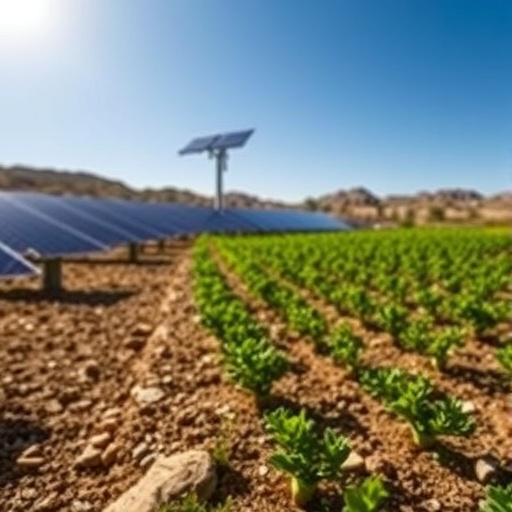In the relentless pursuit of sustainable solutions amid escalating climate challenges, a groundbreaking study has brought to light the promising role of agrivoltaics in mitigating a critical physiological limitation in dryland agriculture: the midday depression of photosynthesis. Published in npj Sustainable Agriculture, the research unveils how integrating photovoltaic solar panels with conventional crop cultivation not only conserves scarce water resources but also significantly enhances plant productivity during the harshest hours of the day. This innovative approach may redefine resilience strategies for arid and semi-arid farming systems globally.
Dryland regions, characterized by low precipitation and intense sunlight, have historically posed formidable challenges to crop productivity. One of the critical physiological phenomena hampering plant growth in these environments is midday depression of photosynthesis, a diurnal dip in photosynthetic efficiency triggered by excessive light intensity, heat stress, and water deficit. During peak sunlight hours, plants undergo photoinhibition and stomatal closure, severely restricting carbon assimilation and reducing growth rates. These physiological stresses cumulatively diminish yield potential, thereby threatening food security under expanding desertification pressures.
.adsslot_1sq9Hz2cDR{width:728px !important;height:90px !important;}
@media(max-width:1199px){ .adsslot_1sq9Hz2cDR{width:468px !important;height:60px !important;}
}
@media(max-width:767px){ .adsslot_1sq9Hz2cDR{width:320px !important;height:50px !important;}
}
ADVERTISEMENT
In their experiments conducted across representative dryland ecosystems, the authors integrated photovoltaic arrays above crop plots and employed continuous physiological monitoring to capture diurnal fluctuations in photosynthesis rates. They discovered that shaded crops under the agrivoltaic setup exhibited significantly higher midday photosynthetic capacity compared to control plots exposed to full sunlight. This empirical data substantiates the hypothesis that agrivoltaics can directly counteract the midday slump, an insight that could recalibrate conventional agronomic practices in arid zones.
Central to understanding this effect is the interplay between photosynthetic photon flux density (PPFD) and leaf temperature, two pivotal factors influencing photosynthesis. Under unshaded conditions, midday PPFD often exceeds saturation thresholds, causing damage to the photosystems and triggering photoprotective mechanisms that suppress photosynthetic efficiency. Conversely, agrivoltaic shading reduces PPFD to optimal ranges, maintaining photosystem integrity while preventing excessive energy dissipation. Simultaneously, leaf temperatures under solar panels were observed to be lower by several degrees Celsius, relieving heat-induced stomatal closure and enabling sustained CO2 uptake.
This dual modulation of light and temperature highlights the inherent climate-smart qualities of agrivoltaics as an adaptive technology. Beyond merely generating renewable energy, these systems function as biophysical regulators that confer resilience to crops in increasingly volatile climates. The authors emphasize that this modality can serve as a scalable, decentralized approach to maintaining agricultural productivity without exacerbating water stress or land-use conflict, a critical advantage in water-limited drylands.
Moreover, the synergistic interactions documented between photovoltaics and vegetation underscore a paradigm shift in how agricultural landscapes are conceptualized. Traditionally, solar installations and farming have been seen as competing land uses. This study disrupts that dichotomy by showcasing the mutualistic benefits of co-location: energy harvested above crops reduces the carbon footprint of food production, while crops shielded from extreme midday conditions achieve higher carbon fixation rates, collectively fostering system-wide sustainability.
The implications of this research extend to global food security narratives and climate mitigation frameworks. As dryland agriculture faces intensifying pressures from warming and drought, innovations that enhance photosynthetic resilience can stabilize yields and reduce the vulnerability of rural communities. Agrivoltaics, by delivering renewable energy alongside optimized crop growth, represents an integrated solution aligning with international goals such as the United Nations Sustainable Development Goals (SDGs) related to zero hunger and affordable clean energy.
Critically, the study’s methodological rigor also provides a blueprint for future agronomic research to refine agrivoltaic designs. Variables such as panel density, orientation, and crop species specificity were systematically evaluated, revealing that fine-tuning such parameters can maximize the benefits while minimizing potential trade-offs like reduced understory light for shade-intolerant crops. These findings pave the way for precision agrivoltaic systems tailored to diverse agroecological contexts.
Importantly, the research underscores that agrivoltaic solutions demand interdisciplinary collaboration, integrating agronomy, plant physiology, renewable energy engineering, and socio-economic assessment. By fostering this nexus, policies can be better informed to promote adoption, incentivize innovation, and navigate logistical challenges like initial capital costs and system maintenance in resource-constrained settings.
Yet, the authors call for continued empirical validation across diverse crops, climatic regimes, and socio-economic conditions to fully elucidate long-term ecological impacts and practical scalability. Critical questions remain on how agrivoltaics influence soil moisture dynamics, pest pressures, and pollinator behavior — factors intricately linked to agricultural ecosystems. Addressing these knowledge gaps will be vital for responsibly harnessing the full potential of this innovation.
In conclusion, Barron-Gafford and colleagues’ pioneering work elevates agrivoltaics from a conceptual notion to a scientifically validated strategy for overcoming photosynthetic limitations in dryland agriculture. By mitigating midday depression, agrivoltaic systems not only enhance biological productivity but also integrate energy sustainability into farming landscapes. This dual functionality embodies the essence of climate-smart agriculture: harnessing technology to enable productive, resilient, and environmentally harmonious food systems amid a warming planet. As global challenges mount, this research heralds a hopeful avenue where energy and food production coalesce to feed humanity while safeguarding ecosystems.
Subject of Research:
Agrivoltaics as a sustainable solution to mitigate midday depression in photosynthesis in dryland crops.
Article Title:
Publisher Correction: Agrivoltaics as a climate-smart and resilient solution for midday depression in photosynthesis in dryland regions.
Article References:
Barron-Gafford, G.A., Murphy, P., Salazar, A. et al. Publisher Correction: Agrivoltaics as a climate-smart and resilient solution for midday depression in photosynthesis in dryland regions. npj Sustain. Agric. 3, 41 (2025). https://doi.org/10.1038/s44264-025-00087-9
Image Credits: AI Generated
Tags: agrivoltaics in dryland agricultureenhancing plant productivity in arid regionsfood security in desertificationimpact of heat stress on cropsinnovative agricultural practices for climate adaptationintegrating solar energy with crop cultivationmidday depression of photosynthesisphotovoltaic solar panels in agriculturephysiological limitations in plant growthresilience strategies for semi-arid farmingsustainable farming solutionswater conservation in farming





